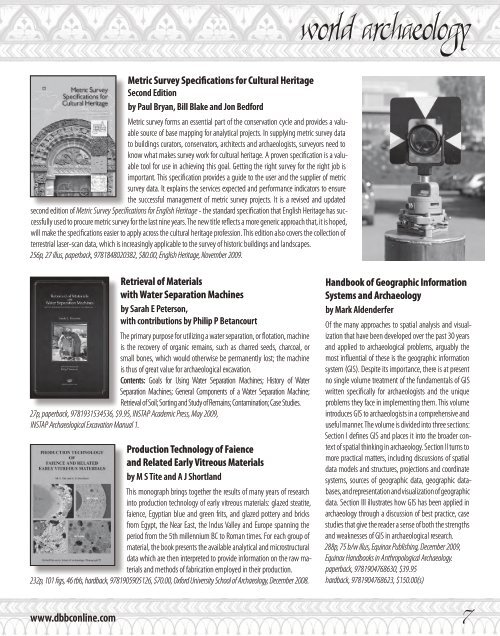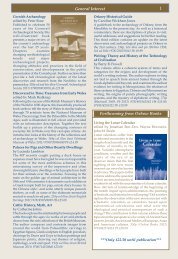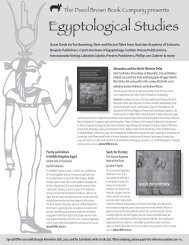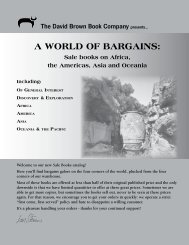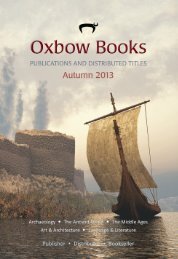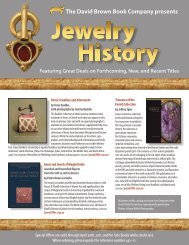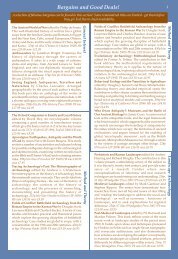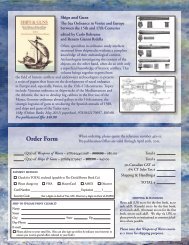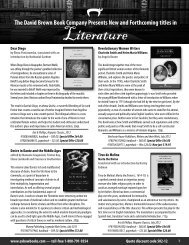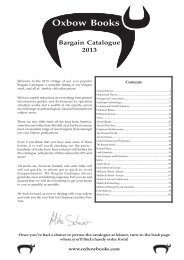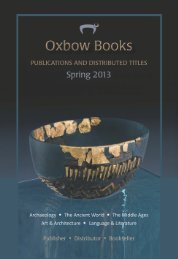New Distributed Titles Fall 2009 - Oxbow Books
New Distributed Titles Fall 2009 - Oxbow Books
New Distributed Titles Fall 2009 - Oxbow Books
You also want an ePaper? Increase the reach of your titles
YUMPU automatically turns print PDFs into web optimized ePapers that Google loves.
Metric Survey Specifications for Cultural Heritage<br />
Second Edition<br />
by Paul Bryan, Bill Blake and Jon Bedford<br />
Metric survey forms an essential part of the conservation cycle and provides a valuable<br />
source of base mapping for analytical projects. In supplying metric survey data<br />
to buildings curators, conservators, architects and archaeologists, surveyors need to<br />
know what makes survey work for cultural heritage. A proven specification is a valuable<br />
tool for use in achieving this goal. Getting the right survey for the right job is<br />
important. This specification provides a guide to the user and the supplier of metric<br />
survey data. It explains the services expected and performance indicators to ensure<br />
the successful management of metric survey projects. It is a revised and updated<br />
second edition of Metric Survey Specifications for English Heritage - the standard specification that English Heritage has successfully<br />
used to procure metric survey for the last nine years. The new title reflects a more generic approach that, it is hoped,<br />
will make the specifications easier to apply across the cultural heritage profession. This edition also covers the collection of<br />
terrestrial laser-scan data, which is increasingly applicable to the survey of historic buildings and landscapes.<br />
256p, 27 illus, paperback, 9781848020382, $80.00, English Heritage, November <strong>2009</strong>.<br />
Retrieval of Materials<br />
with Water Separation Machines<br />
by Sarah E Peterson,<br />
with contributions by Philip P Betancourt<br />
The primary purpose for utilizing a water separation, or flotation, machine<br />
is the recovery of organic remains, such as charred seeds, charcoal, or<br />
small bones, which would otherwise be permanently lost; the machine<br />
is thus of great value for archaeological excavation.<br />
Contents: Goals for Using Water Separation Machines; History of Water<br />
Separation Machines; General Components of a Water Separation Machine;<br />
Retrieval of Soil; Sorting and Study of Remains; Contamination; Case Studies.<br />
27p, paperback, 9781931534536, $9.95, INSTAP Academic Press, May <strong>2009</strong>,<br />
INSTAP Archaeological Excavation Manual 1.<br />
Production Technology of Faience<br />
and Related Early Vitreous Materials<br />
by M S Tite and A J Shortland<br />
This monograph brings together the results of many years of research<br />
into production technology of early vitreous materials: glazed steatite,<br />
faience, Egyptian blue and green frits, and glazed pottery and bricks<br />
from Egypt, the Near East, the Indus Valley and Europe spanning the<br />
period from the 5th millennium BC to Roman times. For each group of<br />
material, the book presents the available analytical and microstructural<br />
data which are then interpreted to provide information on the raw materials<br />
and methods of fabrication employed in their production.<br />
232p, 101 figs, 46 tbls, hardback, 9781905905126, $70.00, Oxford University School of Archaeology, December 2008.<br />
world archaeology<br />
Handbook of Geographic Information<br />
Systems and Archaeology<br />
by Mark Aldenderfer<br />
Of the many approaches to spatial analysis and visualization<br />
that have been developed over the past 30 years<br />
and applied to archaeological problems, arguably the<br />
most influential of these is the geographic information<br />
system (GIS). Despite its importance, there is at present<br />
no single volume treatment of the fundamentals of GIS<br />
written specifically for archaeologists and the unique<br />
problems they face in implementing them. This volume<br />
introduces GIS to archaeologists in a comprehensive and<br />
useful manner. The volume is divided into three sections:<br />
Section I defines GIS and places it into the broader context<br />
of spatial thinking in archaeology. Section II turns to<br />
more practical matters, including discussions of spatial<br />
data models and structures, projections and coordinate<br />
systems, sources of geographic data, geographic databases,<br />
and representation and visualization of geographic<br />
data. Section III illustrates how GIS has been applied in<br />
archaeology through a discussion of best practice, case<br />
studies that give the reader a sense of both the strengths<br />
and weaknesses of GIS in archaeological research.<br />
288p, 75 b/w illus, Equinox Publishing, December <strong>2009</strong>,<br />
Equinox Handbooks in Anthropological Archaeology.<br />
paperback, 9781904768630, $39.95<br />
hardback, 9781904768623, $150.00(s)<br />
www.dbbconline.com 7


